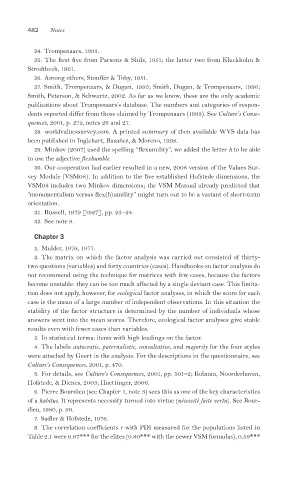Page 517 - Cultures and Organizations
P. 517
482 Notes
24. Trompenaars, 1993.
25. The fi rst five from Parsons & Shils, 1951; the latter two from Kluckhohn &
Strodtbeck, 1961.
26. Among others, Stouffer & Toby, 1951.
27. Smith, Trompenaars, & Dugan, 1995; Smith, Dugan, & Trompenaars, 1996;
Smith, Peterson, & Schwartz, 2002. As far as we know, these are the only academic
publications about Trompenaars’s database. The numbers and categories of respon-
dents reported differ from those claimed by Trompenaars (1993). See Culture’s Conse-
quences, 2001, p. 274, notes 26 and 27.
28. worldvaluessurvey.com. A printed summary of then available WVS data has
been published in Inglehart, Basañez, & Moreno, 1998.
29. Minkov (2007) used the spelling “flexumility”; we added the letter h to be able
to use the adjective fl exhumble.
30. Our cooperation had earlier resulted in a new, 2008 version of the Values Sur-
vey Module (VSM08). In addition to the five established Hofstede dimensions, the
VSM08 includes two Minkov dimensions; the VSM Manual already predicted that
“monumentalism versus flex(h)umility” might turn out to be a variant of short-term
orientation.
31. Russell, 1979 [1927], pp. 23–24.
32. See note 9.
Chapter 3
1. Mulder, 1976, 1977.
2. The matrix on which the factor analysis was carried out consisted of thirty-
two questions (variables) and forty countries (cases). Handbooks on factor analysis do
not recommend using the technique for matrices with few cases, because the factors
become unstable: they can be too much affected by a single deviant case. This limita-
tion does not apply, however, for ecological factor analyses, in which the score for each
case is the mean of a large number of independent observations. In this situation the
stability of the factor structure is determined by the number of individuals whose
answers went into the mean scores. Therefore, ecological factor analyses give stable
results even with fewer cases than variables.
3. In statistical terms: items with high loadings on the factor.
4. The labels autocratic, paternalistic, consultative, and majority for the four styles
were attached by Geert in the analysis. For the descriptions in the questionnaire, see
Culture’s Consequences, 2001, p. 470.
5. For details, see Culture’s Consequences, 2001, pp. 501–2; Kolman, Noorderhaven,
Hofstede, & Dienes, 2003; Huettinger, 2006.
6. Pierre Bourdieu (see Chapter 1, note 3) sees this as one of the key characteristics
of a habitus. It represents necessity turned into virtue (nécessité faite vertu). See Bour-
dieu, 1980, p. 90.
7. Sadler & Hofstede, 1976.
8. The correlation coeffi cients r with PDI measured for the populations listed in
Table 2.1 were 0.67*** for the elites (0.80*** with the newer VSM formulas), 0.59***

